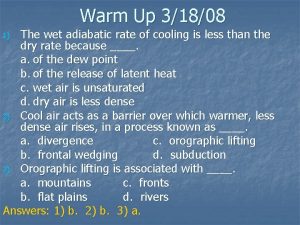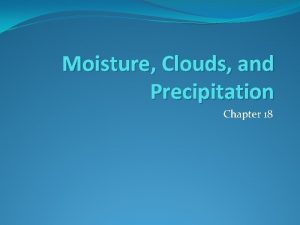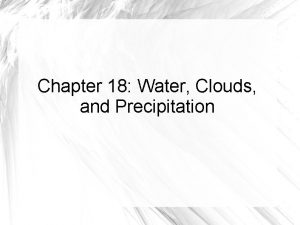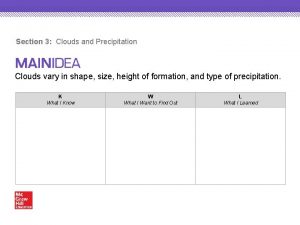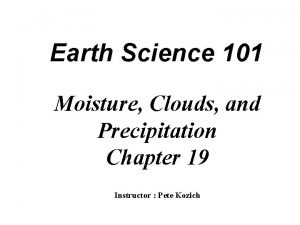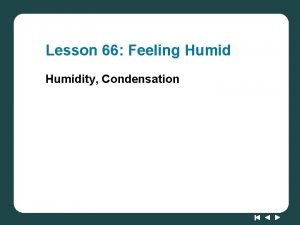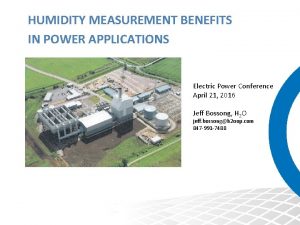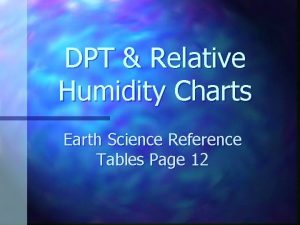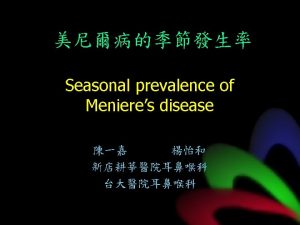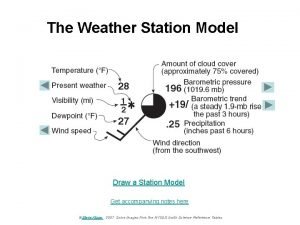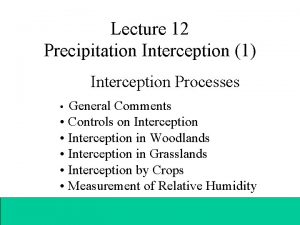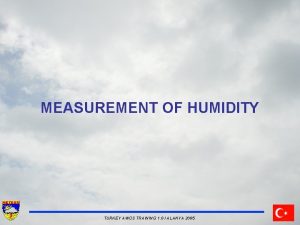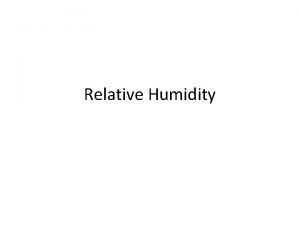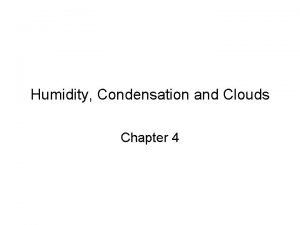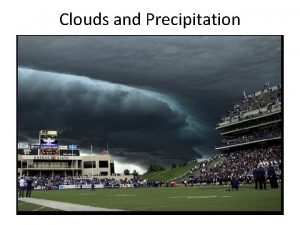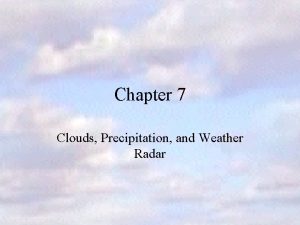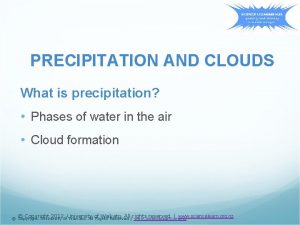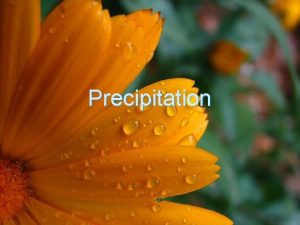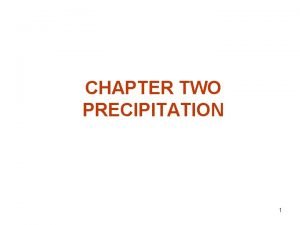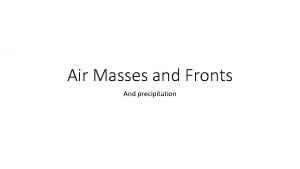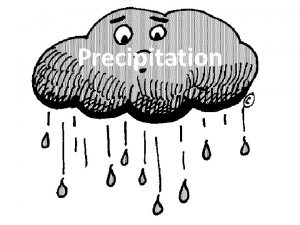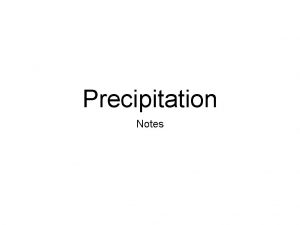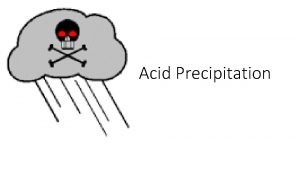Humidity Clouds fogs precipitation The percentages dont add
























- Slides: 24

Humidity Clouds, fogs, precipitation

The percentages don’t add up! Water vapor is considered an add-on and can be as much as 4%. That’s called absolute humidity.

Relative Humidity The capacity of air to carry water vapor depends on temperature. At 10°C the air can only carry 9 grams in each cubic meter of air…

Water vapor is invisible. If you are not at capacity, skies are perfectly clear.

How close is the air to being at full capacity to hold water as vapor? That depends on (1) the actual amount of vapor and (2) the capacity amount. This ratio is called the Relative Humidity.

RH = w/ws x 100% alternately, RH = e/es x 100% w is called the mixing ratio ws is the saturation mixing ratio. e is the vapor pressure, es is the saturation vapor pressure. When w = ws or e=es, then the RH is 100%. We call that Saturation When air is at saturation, you see clouds or fog.

Use the chart. If the temperature is 50°F which is 10°C, what is the saturation mixing ratio (ws)? Now suppose the actual water vapor content (w) is only 4. 5 g in the same volume. What is the RH?

Answer: at 50°F, ws = 9 grams. If w = 4. 5 g, RH = w/ws x 100% = 4. 5/9 x 100% = 50% Since 1 cubic meter of air is around 1 kg in mass, we express (saturation) mixing ratio in g/kg. It’s hard to measure w and ws In a moment we’ll see an easy way to do it.

This is a fog in the Susquehanna River Valley

You can’t see the valley here because of thick fog. RH = 100% in this fog.

Same view on a foggy day and a clear day.

In this fog the visibility is around ¼ mile (you can’t see farther than that)

Two more views of campus, July 2014

Golden Gate Bridge, San Francisco

Also the Golden Gate Bridge but often you can’t see it through the fog.

Sometimes you only see the top of the bridge

Why is SF bay so foggy? Remember the RH formula, RH = w/ws x 100% To raise RH to 100% (fog), you can increase w or decrease ws. What’s happening here?

Dew is another way you see 100% relative humidity. Water vapor has condensed onto the grass. The dew point is the temperature at which dew forms. RH = 100% when the temperature reaches the dew point temperature (call it Td)

Since ws depends only on Temperature, T, each one has its own ws:

Here’s the fabulous part: Since RH = 100% when T = Td, and RH = w/ws x 100%, then it follows that at saturation, RH = 1 x 100% so w = ws. Since T = Td at saturation and each T has its own ws, then at saturation, the dew point also shows you ws. Furthermore, since w = ws, the mixing ratio (w) at saturation has its own Td. The dew point allows you to easily measure w, which tells you exactly how many grams of water vapor is actually in the air.

Remember, T ≠ ws and Td ≠ w, so NEVER calculate Relative Humidity with the ratio T/Td. Always use RH = w/ws x 100% Find w and ws by using the Dew Point and Temperature. We have tables for this, as you’ve seen.

Here’s the average distribution of fog in the U. S. over the course of a year: Really foggy in NY and New England Not very foggy in Arizona often foggy 1. It’s. Why humidisinit. New England so win is New high. England but rarely foggy in Arizona? 2. It’s hot in Arizona, so ws is high

What’s the difference between a fog and a cloud? Fog Cloud

Next: Clouds
 Compare and contrast clouds and fogs.
Compare and contrast clouds and fogs. Significant figures chem
Significant figures chem Dont ask dont tell political cartoon
Dont ask dont tell political cartoon Dont laugh at me dont call me names
Dont laugh at me dont call me names Co precipitation and post precipitation
Co precipitation and post precipitation Co precipitation and post precipitation
Co precipitation and post precipitation Love of cloud and rain chapter 18
Love of cloud and rain chapter 18 Orographic lifting
Orographic lifting Section 3 clouds and precipitation
Section 3 clouds and precipitation Moisture clouds and precipitation
Moisture clouds and precipitation Click to add titleclick to add subtitle
Click to add titleclick to add subtitle Click to add titleclick to add subtitle
Click to add titleclick to add subtitle Click to add titleclick to add subtitle
Click to add titleclick to add subtitle What is humidity
What is humidity Humidity
Humidity Dew point chart
Dew point chart Humidity 2 optimization
Humidity 2 optimization Earth science reference table dew point
Earth science reference table dew point Webalarm
Webalarm Humidity and meniere's disease
Humidity and meniere's disease What is a weather station model
What is a weather station model Calculate relative humidity
Calculate relative humidity Standar kenyamanan termal sni
Standar kenyamanan termal sni Temperature and humidity monitor turkey
Temperature and humidity monitor turkey Which statement accurately describes humidity?
Which statement accurately describes humidity?
